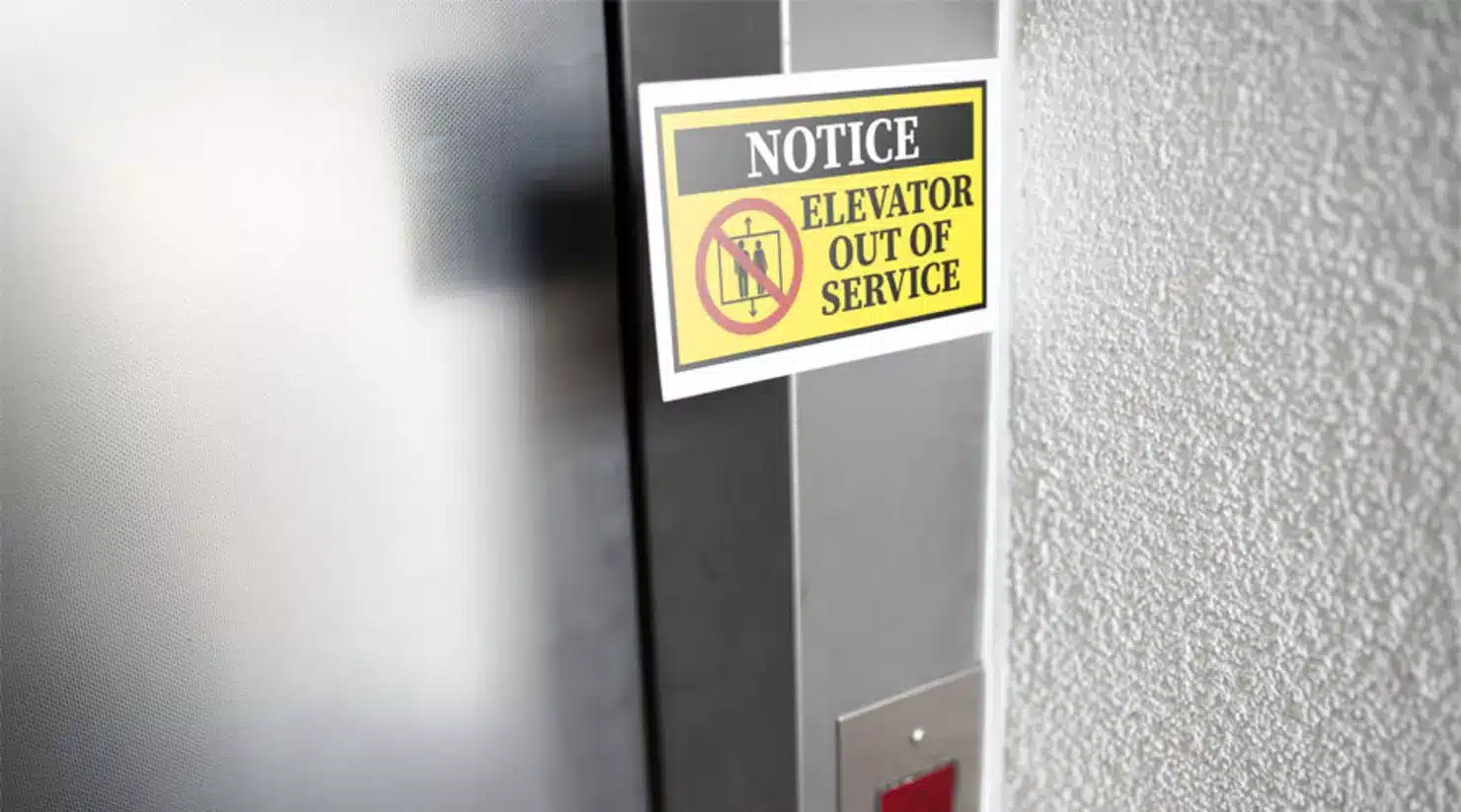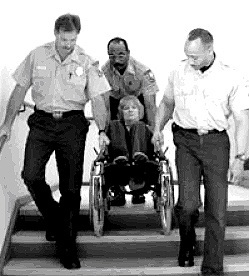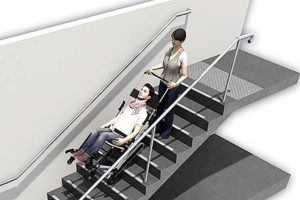
How would you feel being trapped in your hotel room over Christmas?
 Amber Furlong checked into her accessible hotel room in Noosa on 24 December 2023 as part of a family holiday. Her room was on the 3rd floor of her hotel wing, serviced by a single lift. On 26 December, Amber discovered whilst heading for a swim for therapy that the single lift servicing her floor had broken down following severe storms.
Amber Furlong checked into her accessible hotel room in Noosa on 24 December 2023 as part of a family holiday. Her room was on the 3rd floor of her hotel wing, serviced by a single lift. On 26 December, Amber discovered whilst heading for a swim for therapy that the single lift servicing her floor had broken down following severe storms.
Reminiscent of a couple of lines from the Eagle’s song, Hotel California, her experience worsened. After requesting a ground-floor accessible apartment at check-in that ironically was vacant, she was told this would necessitate an upgrade. We are also aware that accessible rooms often remain unoccupied or provided at reduced rates due to the stigmatism associated with staying in a “disabled room.”
“You can check out any time you like,
But you can never leave!”
 The hotel, as I would expect, as is the case for the majority of hotels in Australia, appeared not to have made provision for such an event or at least educated staff on those procedures. Amber experienced difficulty, causing her to miss lunches, dinners and her first trip to the Ocean in a year since becoming paralysed.
The hotel, as I would expect, as is the case for the majority of hotels in Australia, appeared not to have made provision for such an event or at least educated staff on those procedures. Amber experienced difficulty, causing her to miss lunches, dinners and her first trip to the Ocean in a year since becoming paralysed.
On 28 December 23, as the hotel had no contingencies for such an occurrence, Amber was forced to ‘bum’ her way down the stairs. The term ‘bum’ is used by people with disability to go places and as expected on their bottoms, including going up or down stairs where lifts are not provided or due to lift failure. Access to food, water, and the sourcing of catheters also became problematic for Amanda during this period.
What can Hospitality learn from this experience?
It is evident in this circumstance that management plans were not in place for such an incident or had not been conveyed to staff. I suggest the hotel is not alone in having procedures in place for such an incident; from my experience, most accommodation providers do not. So, I would like to use this as a learning exercise for all hospitality providers and examine how things can be done better in assisting people with disability in such circumstances.
I think this is an inherent issue within the industry, but rather than naming the hotel, I will instead look at what policies should be in place that will make a difference to guests with disability when unforeseen incidents occur in the future. I am going to look at this from two positions:
- How accommodation providers support people in life-threatening emergencies like fire, earthquakes, etc.
- How accommodation providers support people due to natural events such as storms resulting in power or infrastructure failure causing lift outages.
“People with disabilities are reluctant to book accommodation in multi-storey hotels for fear of being trapped in the event of an emergency. By having emergency evacuation devices, you’re giving travellers peace of mind and more incentive to book with your hotel”.
Kerry Williams
The Accessible Group
Building Legislation
The first thing we need to understand is what legislation applies to the emergency evacuation/Life safety of people with disability.
Access to Buildings must be provided to meet the performance requirements D1P1 Access for people with disability and D1P2 Safe movement to and within a building. There are then a series of prescriptive or deemed-to-satisfy requirements to assist designers in developing accommodations.
Not surprisingly, Australian building regulators, the Australian Building Codes Board (ABCB), do not believe it is worthwhile developing and incorporating prescriptive requirements to protect people with disability inside buildings in an emergency, no matter the disability. Instead, they fall back on a handful of ‘performance requirements’ that require a design solution prepared by engineers who do not understand disability.
D1P4 Exits
Exits must be provided from a building to allow occupants to evacuate safely, with their number, location and dimensions being appropriate to—
(a) the travel distance, and
(b) the number, mobility and other characteristics of occupants and
(c) the function or use of the building and
(d) the height of the building and
(e) whether the exit is from above or below ground level.
D1P5 Fire-isolated exits
To protect evacuating occupants from a fire in the building exits must be fire-isolated, to the degree necessary, appropriate to—
(a) the number of storeys connected by the exits; and
(b) the fire safety system installed in the building; and
(c) the function or use of the building; and
(d) the number of storeys passed through by the exits; and
(e) fire brigade intervention.
D1P6 Paths of travel to exits
So that occupants can safely evacuate the building, paths of travel to exits must have dimensions appropriate to—
(a) the number, mobility and other characteristics of occupants and
(b) the function or use of the building.
It is also important to note that, unlike mandatory disability access requirements, there are no prescriptive or deemed-to-satisfy requirements to assist designers and fire engineers in developing a building that can be evacuated by people with disability.
Fire Engineering

A fire engineer must consider all elements of the performance requirements when developing the life-safety design of a hotel; however, what training do fire engineers get about the abilities of people with disability? The reality is that they have no basic understanding, and they may have gained it on the job. It is important, however, for all building designers to consider these disabilities when developing solutions:
- Physical– wheelchair users, amputees, ambulant, etc:
- Intellectual – autism, down syndrome, etc: Maybe able to
- Psychiatric – schizophrenia, depression, etc.
- Neurological – epilepsy, acquired brain injury, Parkinson’s disease, MS
- Learning disabilities – dyslexia, dyscalculia, dysgraphia
- Sensory – hearing, vision, touch

So how can a fire engineer design a building’s emergency systems if they do not thoroughly understand the future occupant’s needs?
Guests may not react to smoke and fire alarms, either delaying their evacuation or not knowing they need to evacuate, and some will not be able to evacuate downstairs independently or may take a lot longer to evacuate due to their disability or because they use a walking frame, crutches or other mobility aid.
Life Threatening Emergency
A life-threatening emergency is a phrase used to describe a situation where someone’s life is in imminent danger. Typically, this results from a fire, earthquake or gas leak. Planning for the evacuation of guests with disability is not just a legal or ethical necessity; it is a critical aspect of emergency management that ensures the safety and dignity of guests during unforeseen events, especially those that exclude the use of lifts. Accepting independent evacuation is not possible, and as with assisted evacuation in most cases, protecting life becomes the paramount consideration followed by the evacuation.
The apartments/rooms within hotels, motels, and serviced apartments must be designed as fire compartments, providing a level of protection before structural failure. This compartmentation of sole occupancy units (SOUs) does not provide absolute protection against smoke, which is the biggest killer of fire.

It typically takes four emergency services personnel* to evacuate one person with disability and a backup crew of four is required for levels five floors above ground level, which is an ineffective use of resources and can slow the overall evacuation time. Instead, by providing evacuation chairs within each accessible/disabled room, Emergency services can reassign personnel to only two rescuers per guest during a multi-level evacuation, rapidly increasing the speed of evacuating all guests with disability
*https://evaculife.com.au/blog/residential-high-rise-evacuation/
Staff responsibility
Management and other staff cannot be responsible for the safe evacuation of guests as they do not have formal evacuation training. Additionally. Staff has the same right as anyone else in the building to evacuate themselves as quickly as possible. The only people that can manage such an evacuation is the emergency services who are specially trained.
Lift Failure of Loss of Utilities.

Should all lifts servicing upper levels, be it one or more, go out of service? what procedures or options should be made available? Firstly, management must notify guests in their room exactly what has happened and that all efforts are being made to get vertical transportation operational. It would be best to allocate one staff to take responsibility for the care of guests and coordinate required services.
The services guests may require include food and drink and medicinal and health supplies; however, should the lift outage be for an extended time, emergency services should be called in to evacuate the guest. However, one variable may affect this option, and that is if the guest is using a motorised wheelchair. These devices include batteries and electric motors and can weigh anywhere from 30KG to 105KG, so transporting them between floors may be an issue.
Should the guests want to remain at the accommodation, the provision of evacuation chairs can assist in getting the guest to the lower floors; they, however, cannot be used to return the guest to the upper floors. This is where a motorised stair climber can be used.
Motorised Stairclimbers

The EvacuLife Power provides an industry-proven, easily managed solution that staff can implement without creating an OH&S risk for the operator or the individual being transported.
* https://evaculife.com.au/product/evaculife-power-mkiii-motorised-stairclimber-evacuation-chair/
Refuges

Where evacuation is not possible, each non-residential level should have a designated area where a person with mobility limitations can safely wait for help during an evacuation. Generally, these are located within stairwells, and each space provided for a person using a wheelchair should be at least 800mm x 1300mm and away from the path to the exit doors or exit stairs. Typically, it is expected that a minimum of two spaces will be provided.
Each area of refuge should have accessible signage identifying the area and an intercom or phone within the area for communicating with emergency services personnel to the FIP). Where there is expected to be a higher number of building occupants on a building level, the number of spaces must be increased.
Management Documents
The management of guests with disability during either an emergency evacuation or lift failure should be reviewed and fully documented for all expected scenarios. This will allow staff to respond to incidents in the most appropriate manner. These documents should form part of staff induction and be easily accessed in both digital format and printed format (power failure)
Part of these documents should be Personal Emergency Evacuation Plans or PEEPs*, which are customised documents that provide the framework for planning and providing emergency evacuation for people with disability.
*https://www.disabilityaccessconsultants.com.au/personal-emergency-evacuation-plans-peep-templates/
Conclusion
Hotels and other accommodation providers play a crucial role in ensuring the safety and well-being of all their guests, including those with disability, during emergencies. Here are key reasons why hotels should meticulously plan for the evacuation or care of people with disabilities:
- Inclusivity and Legal Obligations:
-
- Legal requirements mandate that hotels consider the needs of people with disabilities in their emergency planning.
- Tailored Preparations:
-
- People with disabilities often require specific support during emergencies.
- Tailored preparations before a disaster are essential to address their unique needs.
- Emergency Management Strategies:
-
- Personal Emergency Evacuation Plans (PEEPs) should be prepared for the management of guests with disability.
- Reception should maintain a list of people with disability and their whereabouts during emergencies.
- Consider providing equipment (such as pagers, visual alarms, or SMS notifications) to alert visitors with hearing impairments during evacuations.
- Evacuation Refuges:
-
- In the absence of evacuation lifts, each level should have designated areas where people with mobility limitations can safely wait for help.
- These spaces should be adequately sized, away from exit paths, and equipped with communication devices for contacting emergency services3.
-
- Evacuation Chairs:
-
- Evacuation chairs are foldable mobile chairs used to evacuate people with disabilities downstairs.
- These chairs are critically important for those with mobility limitations.
- Smoke Masks/Escape Hoods:
-
- Wearing a smoke mask will protect guests from toxic smoke that kills faster than fire
- Quick and easy to fit in under 30 seconds.
- Safety Outside the Building:
-
- Emergency refuges are designed as safe waiting areas for people with disabilities.
- However, the ultimate safe place during an emergency is outside the building.
In summary, hotels should prioritize the safety and well-being of all guests, including those with disability, by implementing comprehensive emergency plans and considering their unique needs during evacuations.
Product Videos
EvacuLife Escape Evacuation Chair
The EvacuLife Escape Evacuation Chair is a lightweight single-user operation emergency evacuation chair. It glides downstairs quickly and smoothly to ensure no heavy lifting or manual handling is required when an emergency evacuation such as fire, earthquake, terrorist attack or flooding and can be easily used by one operator.
More information here EvacuLife Escape Evacuation Chair
Emergency Evacuation Smoke and Fire Mask
Toxic smoke kills faster than fire – our smoke masks and emergency escape hoods protect you from this fate. If you can protect yourself, you can then help others. Designed to be lightweight and adjustable, the smoke masks can be used by adults and children, making them perfect for home, school, university, and workplaces.
More information here Emergency Evacuation Smoke and Fire Masks
EvacuLife Power Motorised Stair Climber
The EvacuLife Power MKIII is our industry-leading motorised stair climber that assists people with mobility impairment up and downstairs. It’s perfect for use in commercial and residential sectors, for example, in 2 or more storey homes or workplaces. The EvacuLife Power provides an industry-proven, easily managed solution that staff can implement without creating an OH&S risk for the operator or the individual being transported.
More information here EvacuLife Power Motorised Stair Climber

